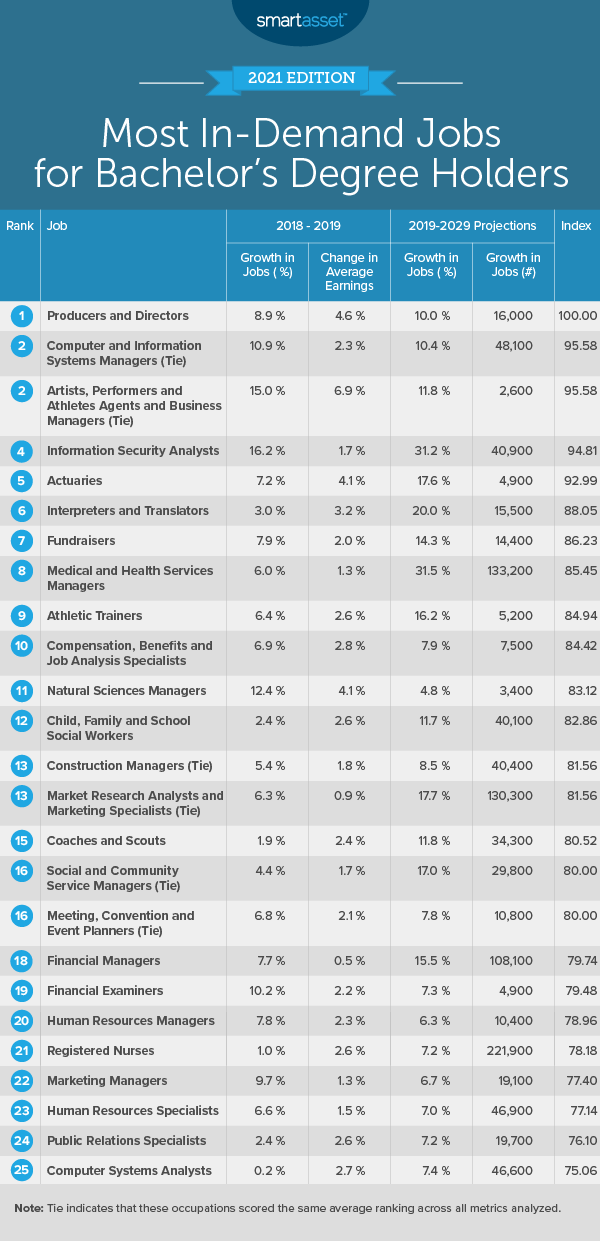Jobs requiring a bachelor’s degree or higher level of education for entry are often more insulated from unemployment than others. During the COVID-19 pandemic, total unemployment for individuals 25 years and older spiked to 13.1% in April 2020. However, the highest unemployment rate over the past year for bachelor’s degree holders 25 and older was 8.4% in April 2020. As of November 2020, the national unemployment rate was 6.7% – 2.5 percentage points higher than the unemployment rate for bachelor’s degree holders.
Some jobs for bachelor’s degree holders may be even more insulated from economic changes as demand is high. In this study, we investigated the most in-demand jobs for bachelor’s degree holders. We compared a total of 131 occupations across four metrics: percentage change in average earnings from 2018 to 2019, percentage change in employment from 2018 to 2019, projected employment change from 2019 to 2029 and projected percentage change in employment from 2019 to 2029. For details on our data sources or how we put all the information together to create our final rankings, check out the Data and Methodology section below.
This is SmartAsset’s third annual study on the most in-demand jobs for bachelor’s degree holders. Check out the 2020 rankings here.
Key Findings
- A list similar to last year. Almost half of the 10 most in-demand jobs for bachelor’s degree holders in 2021 were in our top 10 last year. They are computer and information systems managers, information security analysts, interpreters & translators and medical & health service managers. Of those four occupations, interpreters & translators saw the biggest jump between the two years, moving down five spots from first to sixth.
- More than 30% growth expected in two occupations. On average across the 131 occupations in our study, employment is expected to grow by 5.0% between 2019 and 2029. But the expected growth is more than six times higher for two occupations – information security analysts and medical & health service managers. The Bureau of Labor Statistics (BLS) predicts employment increases of 31.2% and 31.5% for those two occupations, respectively, between 2019 and 2029.

1. Producers and Directors
The producer and director occupation ranks in the top quartile of our study for all four metrics we considered. Between 2018 and 2019, employment of producers and directors grew by almost 9%, while average earnings rose by about 5%. Moreover, the BLS projects the occupation will continue to grow. According to their estimates, the number of producers and directors will increase by 16,000, or 10.0%, from 2019 to 2029.
2. Computer and Information Systems Managers (tie)
The computer and information systems manager occupation ranks in the top 15% of occupations for three of the four metrics in our study. The occupation saw the ninth-largest percentage increase in employment from 2018 to 2019, growing by 10.87%. Between 2019 and 2029, the BLS expects it will grow by another 10.4%, adding 48,100 workers. Across all 131 occupations, that is the 19th-highest percentage increase and ninth-largest gross increase in workers.
2. Agents and Business Managers of Artists, Performers and Athletes (tie)
The occupation of agent and business manager for artists, performers and athletes ties with computer and information systems manager as the No. 2 in-demand job for bachelor’s degree holders. Between 2018 and 2019, average pay for agents and business managers for artists, performers and athletes grew by almost 7%, the seventh-highest rate across all 131 occupations. Over the same time period, employment grew by 15%, second-highest in our study for this metric.
4. Information Security Analysts
Information security analyst is the fourth most in-demand job for bachelor’s degree holders, moving up from fifth place last year. Though average earnings grew at a comparable pace year-over-year, employment increased sharply in this profession. BLS estimates show that information security analyst employment increased by 16.20%. There were about 108,100 information security analysts in 2018 and almost 125,600 in 2019.
5. Actuaries
Most actuaries work for insurance companies, assessing the financial costs of risk and uncertainty. Between 2018 and 2019, average earnings for actuaries grew by 4.06% – the 15th-highest one-year earnings increase in our study. Additionally, between 2019 and 2029, employment for this occupation is expected to grow by another 17.6%, the seventh-largest percentage change in employment in the study.
6. Interpreters and Translators
According to BLS employment projections, the number of interpreters and translators in the U.S. is expected to increase by 20.0% between 2019 and 2029, a top-five rate in our study. With that projected percentage change, employment will grow by roughly 15,500 workers, a top-30 rate. Most recently, from 2018 to 2019, average earnings for interpreters and translators grew by 3.20%, the 25th-highest rate for this metric in the study.
7. Fundraisers
The occupation of fundraiser ranks in the top third of all 131 occupations for three of the four metrics we considered. Between 2018 and 2019, employment grew by 7.87%, the 19th-highest rate. Looking forward, total employment of fundraisers is expected to grow by 14,400, or 14.3%, over the next 10 years – the 30th-largest gross increase and 11th-highest percentage increase.
8. Medical and Health Service Managers
Medical and health service managers plan and coordinate the business activities of healthcare providers. Average earnings for medical and health service managers are high and growing. In 2018 and 2019, average earnings for workers in the occupation stood at $113,730 and $115,160, respectively. Additionally, across the 131 occupations in our study, BLS expects the profession to have the third-largest gross employment increase (133,200 workers) and highest percentage employment increase (31.5%) over approximately the next decade.
9. Athletic Trainers
Between 2019 and 2029, the occupation of athletic trainer is expected to grow by 16.2%, the ninth-highest rate for this metric in our study. Athletic trainers may also see their earnings continue to grow over time. Between 2018 and 2019, average earnings for athletic trainers increased by 2.56% from about $49,300 to more than $50,500.
10. Compensation, Benefits and Job Analysis Specialists
Compensation, benefits and job analysis specialist rounds out our list of the top 10 most in-demand jobs for bachelor’s degree holders. Average earnings for compensation, benefits and job analysis specialists grew by 2.84% between 2018 and 2019, 33rd-highest in our study. The occupation ranks within the top third of the study for the other three metrics as well. It had the 26th-highest percentage change in employment from 2018 to 2019 (6.88%), the 43rd-greatest projected gross employment change from 2019 to 2029 (7,500) and the 28th-highest projected percentage employment change from 2019 to 2029 (7.9%).
Data and Methodology
To find the most in-demand jobs for bachelor’s degree holders, we looked at data for 131 occupations that the BLS classifies as typically requiring a bachelor’s degree for entry. We compared the 131 occupations across four metrics:
- Percentage change in average earnings from 2018 to 2019. Data comes from BLS Occupational Employment Statistics and is for May 2018 and May 2019.
- Percentage change in employment from 2018 to 2019. Data comes from BLS Occupational Employment Statistics and is for May 2018 and May 2019.
- Projected employment change from 2019 to 2029 (gross figure). This is the projected change in the total number of people employed in an occupation from 2019 to 2029. Data comes from the BLS 2019 Employment Projections.
- Projected employment change from 2019 to 2029 (percentage change). This is the projected percentage change in the number of people employed in an occupation from 2019 to 2029. Data comes from the BLS 2019 Employment Projections.
We ranked each occupation in every metric, giving a full weighting to all metrics. We then found each occupation’s average ranking and used that to determine a final score. The occupation with the best average ranking received a score of 100 while the occupation with the worst average ranking received a score of 0.
Tips for Making Educated Choices With Your Earnings
- Invest early. With relatively high income and earnings, many bachelor’s degree workers may be able to have an early retirement. To do this, it is important to take advantage of compound interest by investing early. Take a look at our investment calculator to see how your investment in a savings account can grow over time.
- Contribute to a 401(k). A 401(k) is an employer-sponsored defined contribution plan in which you divert pre-tax portions of your monthly paycheck into a retirement account. Some employers will also match your 401(k) contributions up to a certain percentage of your salary, meaning that if you chose not to contribute, you are essentially leaving money on the table. Our 401(k) calculator can help you determine what you saved for retirement so far and how much more you may need.
- Consider professional help. A financial advisor can help you make smarter financial decisions to be in better control of your money. Finding the right financial advisor that doesn’t have to be hard. SmartAsset’s free tool matches you with financial advisors in your area in five minutes. If you’re ready to be matched with local advisors that will help you achieve your financial goals, get started now.
Questions about our study? Contact us at press@smartasset.com.
Photo credit: ©iStock.com/martin-dm
